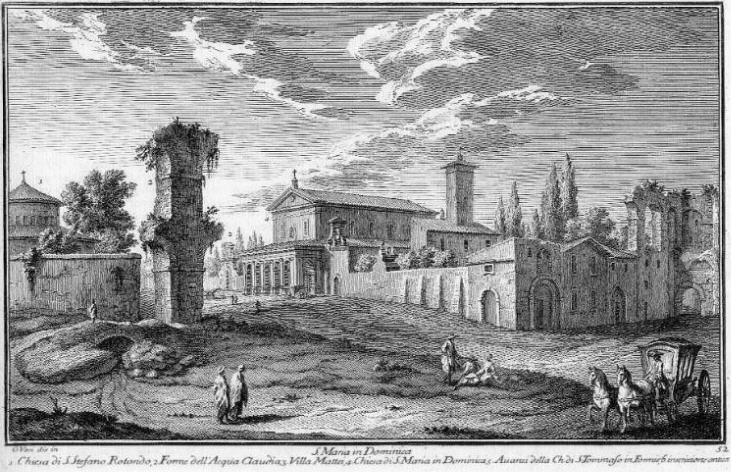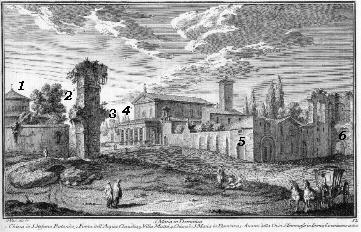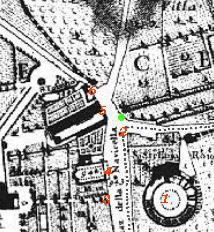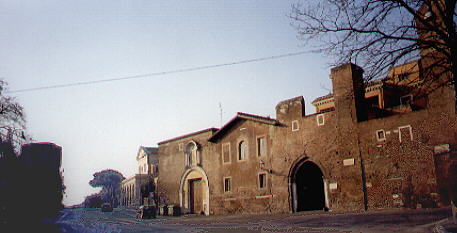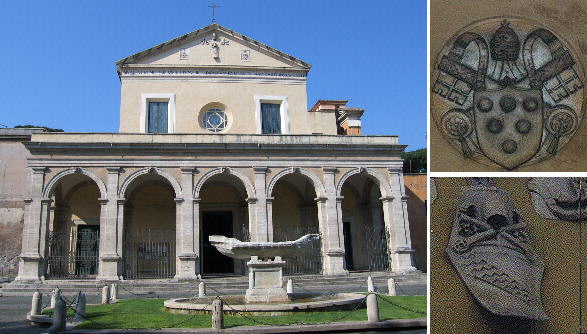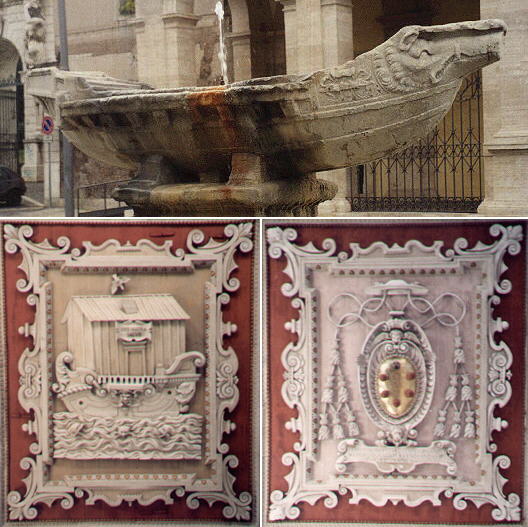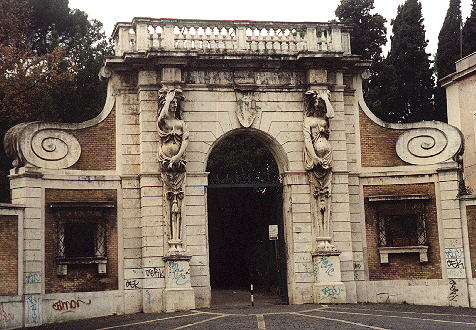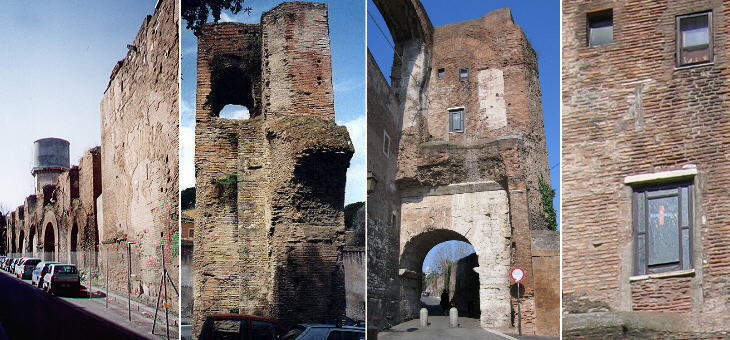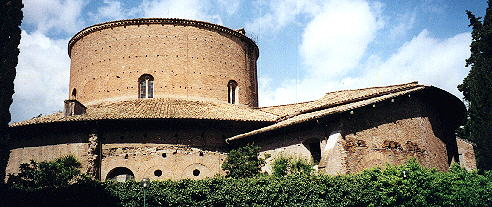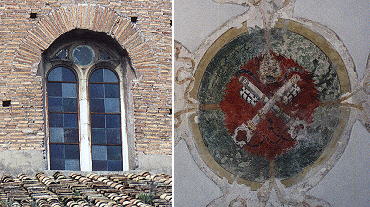

S. Maria in Dominica (Book
3) (Map
B3) (Day 1) (View C10)
(Rione Campitelli) and (Rione Monti)
In this page:
The plate by Giuseppe Vasi
Today's view
S. Maria in Dominica
La Navicella
Villa Mattei
S. Tommaso in Formis
Rovine dell'Acqua Claudia e Arco di Dolabella
S. Stefano Rotondo
The Plate (No. 52)
This plate shows several interesting subjects belonging to different
periods of the history of Rome, from Roman ruins to medieval and Renaissance
churches. The view is taken from the green dot in the small 1748 map below.
In the description below the plate Vasi made reference to: 1) S. Stefano Rotondo;
2) Ruins of Acqua Claudia; 3) Entrance to Villa Mattei; 4) S. Maria in Domnica; 5) S. Tommaso in Formis;
6) Ancient inscription (Arco di Dolabella). The dotted line in the small map delineates the border between Rione Campitelli and Rione Monti (lower right quarter).
Today
Although the street is now much larger the area on the top of the Celio hill has retained its evocative appearance.
S.
Maria in Dominica
The church is one of the oldest deaneries in Rome, rebuilt by Pasquale
I in 817. Cardinal Giovanni de' Medici who later became Leo X erected the
portico under Innocentius VIII. On the arches the head of a lion is a symbol
of the pope (see background). The coat of arms on the façade celebrates
Innocentius VIII, while the coat of arms of Leo X is in the portico.
La Navicella
Navicella=little ship is a copy made by order of Leo X of a Roman
small marble found in the area. The theme of the little ship appears again in the beautiful late Renaissance wooden ceiling of the church.
Villa
Mattei
The current entrance to Villa Mattei is not that shown in the plate. It is the former main entrance to Villa Giustiniani and it
was moved to this site in the 1920s when Villa Mattei was bought by the State and opened to the public. This entrance dates back to the early XVIIth century and it was designed by Carlo Lambardi. The Villa is also called Celimontana with reference to its location
(Mons Celius).
S.
Tommaso in Formis
These medieval buildings were part of the hospital annexed to the
church of S. Tommaso in Formis. This church belonged to the Trinitarian
order which was devoted to ransoming christian slaves. The mosaic medallion
was executed in the XIIIth century and shows Christ between a white and
a black slave. The Trinitarians built in Via Condotti in the XVIIIth century
the Chiesa della SS. Trinità.
Rovine dell'Acqua Claudia e Arco di Dolabella
The ruins in the plate belong to the aqueduct built by the Emperor
Claudius (Acqua Claudia), which brought water to the Imperial Palaces on the Palatinus (another stretch of the aqueduct can be seen near Porta Maggiore).
The inscription mentioned by Vasi in the plate celebrates the erection of an arch (most likely a gate of the old republican walls) by the consuls Dolabella and Silliano in A. D. 10. Eventually the arch
was incorporated in the aqueduct. The street under the arch leads to SS. Giovanni e Paolo. St. John of Matha, the founder of the Trinitarian order lived from 1209 to his death in1213 in
two narrow rooms made out of the aqueduct pillar above the arch.
S.
Stefano Rotondo
The largest circular church in Rome was erected at the close of the
Vth century by Pope Simplicius on top of previous buildings, most likely
the Macellum Magnum of the Emperor Nero. Recent excavations found traces
of a Mithraeum, a temple of the monotheist religion the Christians most
feared. Pope Nicholas V (see his painted coat of arms) restored it and
limited the church by leaving out the outer ring (using a small part of
it to make a portico).
Read Charles Dickens's account of his visit to this church in 1845.
Excerpts from Giuseppe Vasi 1761 Itinerary related to this page:
Chiesa di S. Stefano Rotondo
Prese un tal nome questa chiesa dalla rotondità del tempio, da alcuni creduto di
Claudio. Simplicio I. che fu del 470. lo consagrò al sommo Iddio in onore del santo
Titolare, ed era superbamente ornato di marmi, e di mosaici; ma ridotto poi quasi
rovinato da Niccolò V. fu ristaurato; e da Gregorio XIII. fu, unito al collegio Germanico
presso s. Apollinare. Le pitture, che si vedono d'intorno, furono fatte da Niccolò
Pomarancio, e da Antonio Tempesta; ma poi essendo per l'umido patite, furono tutte ritoccate.
Quindi voltando a sinistra, si vede un prato, ed in mezzo una navicella fatta di marmo,
ed incontro la
Chiesa di S. Maria in Domnica
Nel più alto sito del monte Celio, ove furono gli alloggiamenti de' soldati pellegrini,
siede questa chiesa, detta dalli Scrittori ecclesiastici in Domnica o in Ciriaca
da quella Matrona romana, che come diremo fra poco, dette sepoltura a s. Lorenzo,
la quale quì aveva una casa, che fu consagrata in chiesa, e secondo alcuni,
fu diaconia del santo Martire Fu rifatta da Pasquale I., e poi da Leone X. con disegno
di Raffaelle da Urbino, e vi dipinsero il fregio Giulio Romano, e Pierin del Vaga,
ma ora tutto è andato male: e per quella piccola nave di marmo, che sta innanzi la chiesa,
si dice alla navicella. A sinistra di questa, appunto incontro alla via,
che va verso il Colosseo, si vede la nobilissima porta dell'antichissima chiesa di
san Tommaso in Formis. fatta di marmi, e mosaici da s. Gio: di
Mata fondatore dell'Ordine del riscatto delli schiavi, nella quale egli morì,
e per molto tempo vi stette il di lui corpo: ma poi essendo abbandonata da quei frati,
fu ridotta in commenda, e dipoi unita al Capitolo di s. Pietro da Bonifazio IX. l'anno 1395.
Si conserva però la memoria della chiesa sotto l'arco, che si
trapassa, in una piccola cappella, ove il.giorno del s. Apostolo viene ad ufiziare
il suddetto Capitolo. Si disse in formis per le forme, o archi dell'acquedotto
dell'acqua Claudia, che rovinate vi si vedono.
|
Next plate in Book 3: SS. Giovanni e Paolo
Next step in Day 1 itinerary: SS. Giovanni
e Paolo
Next step in your tour of Rione Monti: Spedale di S. Giovanni in Laterano
Next step in your tour of Rione Campitelli: Porta Latina

Go
to  or to Book
3 or to my Home
Page on Baroque Rome or to my Home Page on Rome
in the footsteps of an XVIIIth century traveller.
or to Book
3 or to my Home
Page on Baroque Rome or to my Home Page on Rome
in the footsteps of an XVIIIth century traveller.
|


